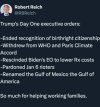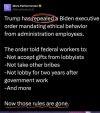“Tariffs are gonna make us rich as hell,” Trump has claimed. But experts tend to disagree.

www.yahoo.com
Nearly all economists disagree with Trump’s take, noting that a tariff actually is an import tax paid by the company doing the importing — not by the foreign country (or foreign business) that’s sending its goods to the U.S.
The same experts have found that most importers simply pass the added cost of tariffs on to U.S. consumers by jacking up their prices— rather than going out of their way to replace the affected goods with American-made alternatives, which still tend to be more expensive. Then other countries retaliate with tariffs of their own, risking a global trade war and recession.
Consider the auto industry. A single car or truck can move back and forth between the U.S. and Canada up to eight times before it’s fully assembled. The entire car seat industry is based in Mexico. Ford’s Maverick pickups, Bronco Sport SUVs and Mustang Mach-E EVs are made in Mexico too. All told, S&P Global estimates that Trump’s tariffs could cost automakers
up to 17% of their annual core profits — which could
translate into a $3,000 price hike for the average car, according to Kelley Blue Book.
The list goes on. Canada exports 80% of its oil to the United States; the U.S. gets half of its imported oil from Canada. As a result, analysts estimate that
gas prices could rise by 25 to 75 cents per gallon under Trump's new tariffs. Your jeans might be made with American cotton and buttons — then sewn in a Mexican factory. U.S. soybeans and corn are sent south, then sent back in packaged food and animal feed. Cheap avocados, mangos and tomatoes flow north, even in the winter months; they could
cost U.S. shoppers 15% more if Trump’s tariffs are enacted. One analyst recently predicted a
4.5% price increase for Corona and Modelo beer. Medicines (and their ingredients) are
often imported to help keep prices down. So are building materials such as steel and aluminum; if they get more expensive,
prices for new homes and renovations will likely follow.
According to a recent summary of the economic research
conducted by the Harvard Business Review, Trump’s 2017-21 “tariffs didn’t lower the cost of imports from China” and “manufacturing jobs didn’t come back to the U.S.” — yet “U.S. consumers paid more on specific goods” and “sectors targeted by retaliatory tariffs,” especially agriculture, “took a hit.”
Now Trump wants to go even further. His biggest 2024 campaign promise on tariffs wasn’t retaliatory — i.e., things from
this country will get taxed at
this rate if
this happens. Instead, he pledged to make tariffs
universal, with a blanket, baseline tax of
10% to 20% on most imports; an additional tax of
60% or more on Chinese goods; and a plan to match the taxes other countries impose on U.S. products, *** for tat.
During his first term, Trump’s advisers reportedly steered him away from this sort of thing, warning that universal tariffs could tank the stock market and depress the economy.
Either way, economists have been clear about the risks ahead. “The 2018-to-2019 trade war was immensely damaging, and [Trump’s universal tariff plan] would go so far beyond that it’s hard to even compare,” Erica York, senior economist at the Tax Foundation, a right-leaning think tank that opposes the tariffs,
told the Washington Post earlier this year. “This threatens to upend and fragment global trade to an extent we haven’t seen in centuries.”

www.newsweek.com




